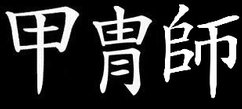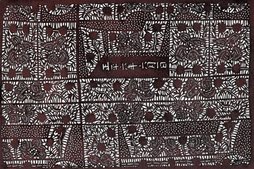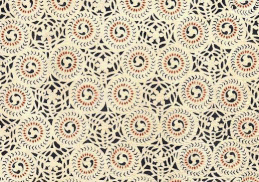For all enquiries...
Copyright Katchushi 2019 on all Text and Photographs
Katchushi Restoration
修復
E-gawa
絵革
E-gawa are the special decorative leathers found adorning various parts of an armour. They have been in use on Japanese armour since the Heian era of Japanese history 平安時代 (794-1185AD) where they are first seen on the great O-yoroi armours of the period.
E-gawa come in many different patterns with the design being stencilled on to soft doeskin using various natural pigments. Today they are still hand-cut, using handmade stencil paper called Katagami 型紙 by the armourer. Commercially produced E-gawa is also made today in Japan although these are screen printed and used for modern reproductions and toy armours for use in the boys festival. Using these on historically important armour is incorrect, as the various types and designs of E-gawa can play an important part in determining the period in which the armour was made. I was fortunate enough to be taught by my teacher in Japan how to make E-gawa by the old traditional method by hand cutting a stencil and then applying the dye.
Katagami型紙
To begin making E-gawa, a stencil has to be cut using handmade stencil paper which is made from Kozo 楮紙 (Japanese mulberry). It is made by pasting about five layers of paper together after which it is then smoked. This is followed by a coating of Kakishibu 柿渋 (astringent persimmon juice) to waterproof it. In the past E-gawa stencils were cut from soft metal sheet (so that they could be used over and over) as well as Katagami stencil paper . Today stencils are still made from metal sheet but using photo etching techniques.
Once the design is drawn it is very carefully cut out using a special handmade knife called a Katagami bocho 型紙包丁. The width of the blade is approx 2mm wide.
After the stencil is cut it is laid on top of the doeskin and the dyes are then applied through the stencil onto the leather. When the stencil is removed the dyes are allowed to dry sometimes up to 2-3 months. This design was a commision to be used on a shoulder strap of a Muromachi period 室町時代 (approx 1333-1573AD) Domaru armour.
This is a stencil I cut for an E-gawa design known as Shoheigawa 正平革 referring to the date that the design was first licensed to be used (1351). The date of the sixth year of Shohei is incorporated into the design. The overall design is of Chinese lions amongst Peony flowers.
The completed Shoheigawa.
Once the dye is dry it the deerskin is then cut and applied to the various facings on a suit of Japanese armour.
This is another design called Mitsu tomoe 三 巴 (three comma's). Also, if you look carefully in the design are three stylised dragonflys surrounding a snowflake. This was made for a commission. The original E-gawa design is Heian period in date although this is a reproduction of an Edo period 江戸時代 (1603-1867) version.
This is a stencil commisioned for use on the Munaita 胸板 (top of a breastplate) on a Muromachi period 室町時代 armour (approx 1336 to 1573 AD). The design is called Mojishi 藻師子and shows dancing lions amongst foliage..
Japanese armour restorer
Japanese armour restorer
Japanese armour restorer
Japanese armour restorer
Japanese armour restorer
Japanese armour restorer
Japanese armour restorer
Japanese armour restorer
Japanese armour restorer
Japanese armour restorer
Japanese armour restorer
Japanese armour restorer
Japanese armour restorer
Japanese armour restorer
Samurai armour restoration
Samurai armour restoration
Samurai armour restoration
Samurai armour restoration
Samurai armour restoration
Katchushi UK
Katchushi UK
Katchushi UK
Katchushi UK
Katchushi UK
Katchushi UK
Katchushi Studio
Katchushi Studio
Katchushi Studio
Katchushi Studio
Katchushi Studio
Katchushi Studio
Katchushi Studio
Katchushi Studio
Katchushi Studio
Japanese Armor Restorer
Japanese Armor Restorer
Japanese Armor Restorer
Japanese Armor Restorer
Japanese Armor Restorer
Japanese Armor Restorer
Japanese Armor Restorer
Japanese armour conservation
Japanese armour conservation
Japanese armour conservation
Japanese armour conservation





